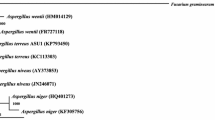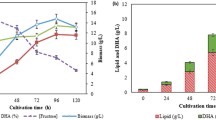Abstract
In this study, the optimisation of the process parameters for riboflavin production by the marine yeast strainCandida membranifaciens subsp.flavinogenie W14-3 was carried out using response surface methodology (RSM) based on Central Composite Designs (CCD). We found that the amount of xylose, pH, temperature and shaking speed had great influence on riboflavin production by strain W14-3. Therefore, a response surface design was used to evaluate the influence of the four factors on the riboflavin production. Then, five levels of the four factors above were further optimised using a Central Composite design. Finally, the optimal parameters for the riboflavin production were obtained with RSM. Under the optimised conditions (the production medium containing 2.0% xylose, pH 4.5, temperature 28°C and shaking speed 170 rpm), 22 μg ml−1 of riboflavin was reached in the culture of strain W14-3 within 54 h of fermentation whereas the predicted riboflavin yield of 22 μg ml−1 was derived from RSM regression.
Similar content being viewed by others
References
Boretsky Y.R., Kapustyak K.Y., Fayura L.R., Stasyk O.V., Stenchuk M.M., Bobak Y.P., Drobot L.B., Sibirny A.A. (2005). Positive selection of mutants defective in transcriptional repression of riboflavin synthesis by iron in the flavinogenic yeastPichia guilliermondii. FEMS Yeast Res., 5: 829–837.
El-Refal S.S.A.H., Gamati S.Y. (1989). Physiological study on riboflavin production by a hydrocarbon-utilizing culture ofCandida guilliermondii Wickerham. J. Islamic Acad. Sci., 2: 27–30.
Fayura L.R., Fedorovych D.V., Prokopiv T.M., Boretsky Y.R., Sibirny A.A. (2007). The pleiotropic nature ofrib80, hit1, andred6 mutations affecting riboflavin biosynthesis in the yeastPichia guilliermondii. Microbiology, 76: 55–59.
Kalil S.J., Maugeri F., Rodrigues M.I. (2000). Response surface analysis and stimulation as a tool for bioprocess design and optimization. Process Biochem., 35: 539–550.
Leathers T.D., Gupta S.C. (1997). Xylitol and riboflavin accumulation in xylose-grown cultures ofPichia guilliermondii. Appl. Microbiol. Biotechnol., 47: 58–61.
Li X.Y., Liu Z.Q., Chi Z.M. (2008). Production of phytase by a marine yeastKodamaea ohmeri BG3 in an oats medium: Optimization by response surface methodology. Bioresour. Technol., 99: 6386–6390.
Plackett R.L., Burman J.P. (1944). The design of optimum multifactorial experiments. Biometrica, 33: 305–325.
Stahmann P., Revuelta J.L., Seulberge H. (2000). Three biotechnical processesAshbya gossypii, Candida famata orBacillus subtilis compete with using chemical riboflavin production. Appl. Microbiol. Biotechnol., 53: 509–516.
Sunitha K., Kim Y.O., Lee J.K., Oh T.K. (2000). Statistical optimization of seed and induction conditions to enhance phytase production by recombinantEscherichia coli. Biochem. Eng. J., 5: 51–56.
Vohra A., Satyanarayana T. (2002). Statistical optimization of the media components by response surface methodology to enhance phytase production byPichia anomala. Process Biochem., 37: 999–1004.
Wang L., Chi Z.M., Wang X.H., Ju L., Chi Z., Guo N. (2008). Isolation and characterization ofCandida membranifaciens subsp.flavinogenie W14-3, a novel riboflavin-producing marine yeast. Microbiol. Res., 163: 255–266.
Wendland J., Walther A. (2005).Ashbya gossypii: A model for fungal development biology. Nat. Rev. Microbiol., 5: 421–429.
Wu Q.L., Chen T., Gan Y., Chen X., Zhao X.M. (2007). Optimization of riboflavin production by recombinantBacillus subtilis RH44 using statistical designs. Appl. Microbiol. Biotechnol., 76: 783–794.
Author information
Authors and Affiliations
Rights and permissions
About this article
Cite this article
Chi, Z., Wang, L., Ju, L. et al. Optimisation of riboflavin production by the marine yeastCandida membranifaciens subsp.flavinogenie W14-3 using response surface methodology. Ann. Microbiol. 58, 677–681 (2008). https://doi.org/10.1007/BF03175574
Received:
Accepted:
Issue Date:
DOI: https://doi.org/10.1007/BF03175574




